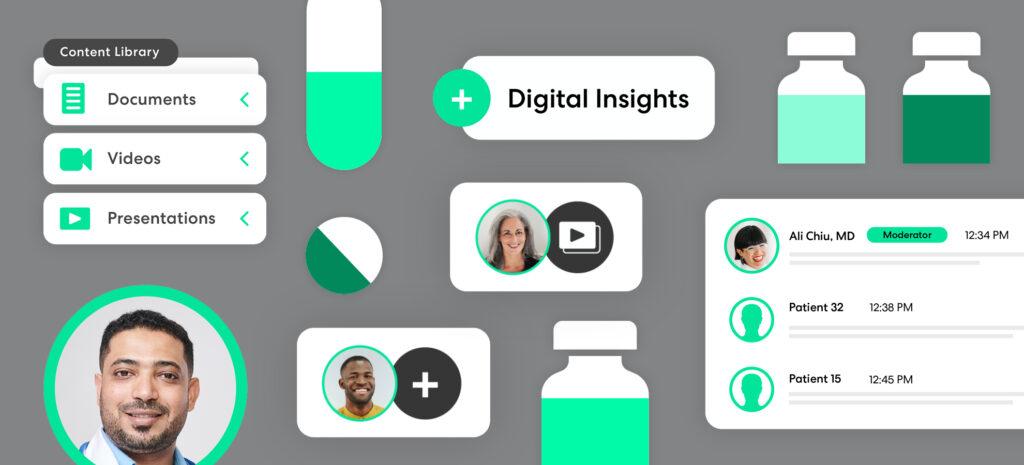Precision medicine, driven in large part to incredible advancements in genomics, is changing treatments for difficult diseases and conditions in ways previously difficult to imagine. Precision treatment for cancer – precision oncology – leaders this charge in many measurable ways.
How doctors treat cancer is rapidly evolving, becoming more refined, complex, and precise. Instead of a one-size-fits-all treatment pathway – often involving chemotherapy – life science companies are developing treatments that target the specific genetic characteristics of an individual cancer patient.
According to the American Cancer Society:
“One of the ways doctors can find out if certain gene or protein changes might affect how a cancer responds to treatment is with pharmacogenomic testing. This type of testing can tell how the person’s body breaks down, absorbs, and uses treatment drugs. Before starting treatment, doctors can test the cancer cells for certain gene and protein changes to help determine which treatments are likely to work best. The goal is to give treatments that are most likely to work, while avoiding giving treatments that might not work. The two types of treatment most often used in precision medicine are targeted drug therapy (drugs designed to attack a specific target on cancer cells) and immunotherapy (medicines used to help the body’s immune system attack the cancer.”
Global oncology teams accomplish more on the Within3 platform
Increasingly, emerging cancer research indicates that every person’s cancer is unique, composed of a distinct amalgamation of mutated genes and cellular changes. Cancer genetics, environment, and lifestyle can significantly impact a patient’s health, symptoms, and how they respond to treatments and precision medicine. (Related: learn more about the difference between precision medicine vs personalized medicine in our detailed guide.)
Thus, we’re seeing an emergence of precision oncology, which seeks to pair the right drugs with the right people according to the genetic or molecular understanding of that specific type of cancer.
Today, we’ll discuss the promises and challenges of precision medicine to treat cancer.
What is precision oncology?
The term is all-encompassing and describes the modern medicinal approach toward cancer. Put simply, specific cancer diagnoses and treatments are tailored to the genetic susceptibilities of the individual patient and cancer type.
The basis of this philosophy can be boiled down to a simple statement: what’s true for large groups of patients may not apply to the individual. As the American Cancer Society states: “All cancers are caused by gene changes of some kind. Cancer cells are abnormal versions of normal cells, meaning something changed in the genes of a normal cell to make it turn into a cancer cell. For example, genes that normally help keep cells from growing out of control might get turned off, or genes that normally help cells grow and divide might get turned on all the time.”
The promise of precision oncology
Thanks to decades of research and technological advancement, scientists and researchers understand different types of cancer better than ever before. Specifically, as researchers from John Hopkins Medicine notes, “The advent of low-cost, next-generation DNA sequencing (NGS) technologies has led to an explosion in individual tumor molecular profiling to identify personalized therapeutic matches for patients with cancer.”
From the heights of this vantage point, scientists can now isolate and break down various cancer cell components from tissue samples to determine the following:
- The drivers of certain types of cancers
- The specific genetic makeup of their tumors
- The inherent vulnerabilities
This knowledge informs the best individual treatment options, helping life science companies bridge the gap between the laboratory and the clinic. It enables them to create novel therapeutics and treatment protocols bespoke to the patient based on their cancer’s genetic change and mutation. This treatment is then designed to specifically target alterations that drive tumor growth and curb the spread of the disease.
Ideally, targeted therapies should be more impactful and result in fewer side effects than traditional treatments – but this isn’t without its challenges.
RELATED CONTENT
A Guide to Successful Clinical Trial Design
Put simply, clinical study design can make or break a study. It must be designed properly to mitigate or entirely eliminate such factors from confusing the results or leading to improper conclusions. Read our comprehensive guide.
3 Patient Retention Strategies for Clinical Trials Retention
Retention – the strategy and tactics designed to keep participants from discontinuing participation and dropping out – keeps a study on track and saves time, costs, and resources. What are some patient retention strategies that clinical trial teams can use to increase their chance for success? Get three effective patient retention strategies.
Challenges in precision oncology
The emergence and importance of precision medicine, including precision oncology, is exciting. Today, doctors can use this tactic to:
- Identify people who might be at high risk
- Help high-risk patients lower their risks
- Discover certain cancers early on
- Diagnose specific cancers accurately
- Select the optimal treatment option
- Evaluate the efficacy of the treatment
That said, developing this therapeutic type is not a simple undertaking. Before a pharmaceutical company starts drug or “combination product” development, it should plan and prepare for the four most common oncological challenges.
Challenge #1: precision oncology is not helpful for every type of cancer
While precision medicine has great promise, scientific understanding, clinical research, and application are ongoing. Because this is a relatively new field of study, precision medicine is not advanced enough to be used for every type of cancer.
Today, researchers estimate that approximately 8%–10% of patients with cancer would benefit from genome-driven oncology. While that may seem small, it’s a dramatic leap forward from just a decade and a half ago, when that figure was a meager 0.7% of patients.
Currently, the most common applications for precision medicine are for the following types of cancers:
- Breast cancer
- Certain types of leukemia
- Certain types of lymphoma
- Colorectal cancer
- Esophageal cancer
- Lung cancer
- Melanoma
- Ovarian cancer
- Stomach cancer
- Thyroid cancer
But researchers hope that, shortly, even more treatments will be customizable to cancer’s specific gene and protein changes, ensuring higher progression-free survival rates.
Challenge #2: oncological trials are more complex
Compared to non-oncological trials, the average oncological trial will cost more, take longer to complete, and have a significantly higher failure rate. According to a report from the Tufts Center for the Study of Drug Development, the average clinical oncology trial takes four years longer to complete – 12 years in total for all three phases.
What causes the delays in these advancements?
The report from Tufts suggested several factors contributed to the difficulty of successfully completing an oncological trial:
- More complex trial design – To target specific genetic markers, trials must be custom designed from the ground up. This combination of customization and unknown factors adds to the complexity of creating an effective trial.
- Trial participation – Trial designers encounter serious hurdles in finding, recruiting, enrolling, and retaining study participants.
- Larger data sets – Oncological trials typically generate significantly higher volumes of trial data. For instance, in phase 2, an oncological trial typically gathers 3.1 million data points per protocol compared to 1.9 million data points for non-oncology trials. More data makes it harder to sift through the information for actionable insights.
- More protocol deviations and amendments – Issues with trial participation contributed to 50%–70% higher rates of deviations and amendments to trial protocols.
Fortunately, various technologies like Within3 have emerged that can help pharmaceutical companies discover solutions for the entire insight lifecycle. A capable insights management platform empowers life science companies to design effective oncological trials, identify and engage key opinion leaders, and deliver data-based answers that inform decision-making.
Challenge #3: lack of data
As with any new field of study, one of the initial barriers to novel, innovative precision oncology therapies is void of scientific knowledge.
With precision oncology, there hasn’t been enough time or data – specifically, preclinical and post-market data – to fully understand the potential applications, benefits, and ramifications of a new therapy. This, in turn, creates a shroud of uncertainty and wariness around clinical trials, particularly when recruiting and enrolling trial participants.
While this issue will likely abate with time, this complex work remains a relatively new and growing field of scientific study.
Challenge #4: patient recruitment obstacles
Enrolling participants is a major hurdle standing in the way of practically every successful clinical trial. Even though 18,000,000 people fight cancer annually, less than 8% of them will participate in a clinical trial.
Historically, the commonly-held belief was that patient reluctance and choice were the predominant factors underwhelming trial participation rates. Commonly cited issues included patient fear and unease surrounding the trial protocol, their assignment, or potential side effects.
While these concerns can and do impact trial participation, recent studies have demonstrated that approximately 3 out of 4 patients don’t participate due to structural or clinical barriers – and this is especially true for oncological trials. Common structural issues include:
- Trial availability – A trial site must be adequately staffed and equipped to conduct a trial and gather lots of data. Smaller sites often lack resources, limiting trials to large cities’ academic medical centers. Also, many patients are unaware that trial participation is an option.
- Site accessibility – Because trials are often limited to big cities, patients in rural areas may be disproportionately impacted. Logistical accessibility issues to the site, such as distance, frequency, and associated costs, may dissuade participants from signing up and staying committed.
- Oncologist recommendations – The most common way patients learn about trials is through their cancer care provider. A patient is far less likely to volunteer if the medical expert fails to propose the trial as the option – whether due to ignorance of the trial’s existence or doubt in its efficacy.
- Clinical staff competence – Some trials lack the structural support, proper trial design, and sufficiently trained, committed, and supported staff willing to drive recruitment and retain participants.
Here, having a powerful insights management platform can combat many of these structural challenges, helping to improve trial recruitment and retention by offering a more equitable, patient-centric approach.
Insights management can help trial researchers identify optimal trial participants, understand patient needs, and improve site selection and access.
4 trends in precision oncology
The field is set to boom over the next decade. The likelihood for this growth is readily apparent when you consider the following industry trends:
- Targeted drugs are on the rise – Since 2000, the number of investigational cancer drug trials targeting cancer has quadrupled, from 421 annual trials to 1489 annual trials. In 2019, 39 of the 48 FDA drug approvals were for targeted treatments, with nearly one-quarter of these cancer therapies.
- Telemedicine – The pandemic encouraged changes that positively impacted existing patients and trial participants. Digital technologies make it easier to reach underserved populations, increasing trial accessibility.
- Greater need – Seeing as cancer typically develops later into adulthood, the oncology market is expected to expand rapidly as the baby boomer population enters late adulthood. According to the National Institute of Health, by 2030, 70% of all cancers will occur among adults over 65.
- Importance of deep phenotyping – Phenotyping is increasingly essential. It translates data from clinical studies into actionable insights. This involves examining the disease and integrating the data with clinical information, genomic testing, and variations.
Technology designed to facilitate effective precision oncology trials
There is great promise in cancer treatment courses tailored to the individual and the unique genetic coding of the patient’s cancer. It’s rapidly becoming the optimal way to detect, diagnose, and treat cancer in many areas.
Put simply; it’s the future of cancer treatment.
But with the significant barriers to entry, massive associated costs and enrollment failure rates, pharmaceutical companies must take a careful and measured approach to clinical trial design and implementation.
For that, an insights management platform can provide the tools and data-driven insights life science companies rely on to create, implement, and accelerate successful precision oncology clinical trials and, ultimately, foster life-changing results for patients worldwide.
Interested in learning how Within3 accelerates pharma innovation, including precision oncology? Start the conversation by booking a demo.






